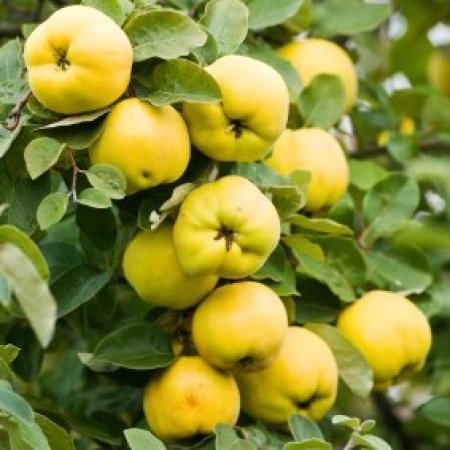Quinces (Cydonia oblonga) are fruit trees related to apples and pears. They require a chilling period to flower (100 to 140 days below 45ºF), and can be grown successfully in cooler tropical climates as well as colder temperate regions. In the U.S. they are hardy to Zones 5-9. As trees, they have an irregular shape and reach heights of 10-15 feet tall.
Quinces are not fussy about soil, but they do require a reasonably sunny site to produce fruit. Ideal conditions would include a deep, moisture-retentive soil that is slightly acidic. Bare-root trees should be planted in the spring, spaced 12-15 feet (4-5 meters) apart. Compact forms can be grown in large containers (18-24 inches in diameter) filled with a soil-based compost.
The first year is a critical time for the establishment of a new quince tree. Trees need at least 1 inch of water each week for best growth and fruit production. This becomes especially critical during dry periods. Inconsistent watering will adversely affect fruit quality. Once established, quinces require very little maintenance. Apply a slow-release, organic fertilizer in the spring, just after flowering, and a low-nitrogen, organic fertilizer (e.g.
Quinces fruit on the tips of the shoots from the previous summer's growth. Bushes may be left to grow into multi-stemmed trees, or like apple trees, pruned with an open-centered, well-spaced framework in the early years of growth. Pruning and training should be done in the dormant season between late autumn and early spring. After the fourth year, only light pruning is necessary apart from the occasional thinning of overcrowded growth or removal of dead and damaged wood. Young trees are prone to developing suckers and water sprouts, which should be removed as soon as they appear.
Quinces are usually ripened like pears'off of the tree. Pick the fruits when the skins have turned from green to gold, usually in late fall (October or early November) and the fruits take on an aromatic fragrance. In warmer climates, the fruit can be left on the tree to ripen (and soften), as long as it is picked before the first frosts.
Store undamaged fruits in boxes in a cool, well-ventilated, dark place, where they will keep for 2 to 3 months. Wrapping the fruits in plastic should be avoided, as it will discolor them internally.Because quinces have a strong aroma, they should be stored separately so that they do not contaminate the flavors of other fruits.
Quinces are generally self-fertile, but cross-pollination from other species will help improve fruit size and the overall volume of your yield. Make sure species used for cross-pollination are within 50 feet of each other and that they bloom at the same time.
Quince trees may be propagated either by chip-budding onto rootstocks in summer (July or August) or by taking hardwood cuttings in fall.
The most widely grown cultivars are:

About The Author: Ellen Brown is an environmental writer and photographer and the owner of Sustainable Media, an environmental media company that specializes in helping businesses and organizations promote eco-friendly products and services. Contact her on the web at http://www.sustainable-media.com
Add your voice! Click below to comment. ThriftyFun is powered by your wisdom!